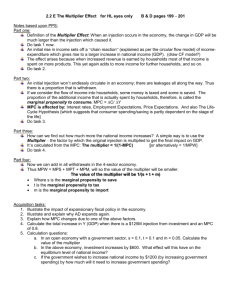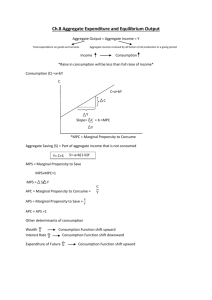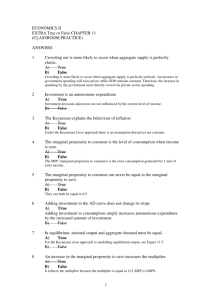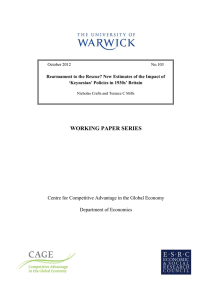What is Propensity to Consumer
advertisement
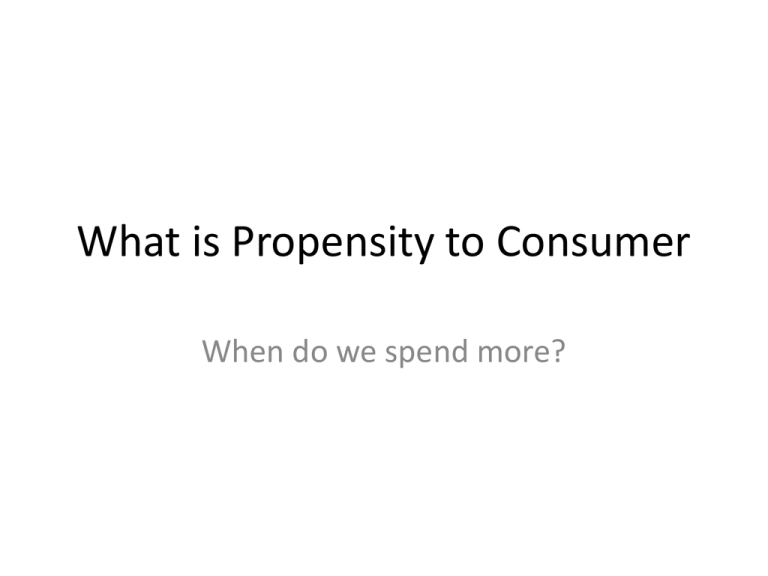
What is Propensity to Consumer When do we spend more? What is the deciding factor on whether you spend or not? • Income • Keynes felt we could learn a lot about consumption by focusing on the relationship between income and spending. • He said income and consumer spending rise in tandem.. • If you know how much income consumers have to spend (Yd), you can predict what they will spend By definition: all disposable income is either spent or saved Yd = C + S Why would we calculate or even consider savings as important? A low savings rate leads to a low productivity rate? Why Because****without savings to invest in new and better capital, we can’t raise our productivity very quickly. Keyne’s Consumption Function Keynes referred to this as “fundamental law” that men are disposed as a rule and on the average, to increase their consumption as their income increases, but not by as much as the increase in their income. *1)At low levels of aggregate income, the consumption expenditures of households will exceed their disposable income (when household income is low, households dissave- they either borrow or draw from past savings to purchase consumption goods Keynes said that the economy needs to be directed to full-employment through aggregate expenditures. (C + I + G + X-M ) Keynes Said: He believed that SPENDING induced business firms to supply g & s. He said if spending FELL then business firms would respond by cutting back production. LESS SPENDING… LEADS TO LESS OUTPUT. He said prices and wages were not flexible. He said- Equilibrium occurs when the level of total spending is equal to current output. When this happens producers have no reason to expand or contract output Consumer’s Behavior • We expect that even with an income level of zero, there will be some consumption. • This is the autonomous consumption. • We expect consumption to rise with income based on the consumer’s MPC. • Dissaving occurs when current consumption exceeds current income – a negative saving flow. The Multiplier • The decline in spending will be much larger than the initial (autonomous) spending decrease. • The multiplier is the multiple by which an initial change in aggregate spending will alter total expenditure after an infinite number of spending cycles. 1 Multiplier = 1 - MPC What really is the multiplier? The multiplier is based on two concepts already covered: 1.GDP is the nation’s expenditure on all the final goods and services produced during the year at market prices. 2.GDP=C+I+G+(X-M) = Aggregate Demand What really is the multiplier? The multiplier is based on two concepts already covered: 1.GDP is the nation’s expenditure on all the final goods and services produced during the year at market prices. 2.GDP=C+I+G+(X-M) = Aggregate Demand Obviously if C goes up the entire GDP will go up also. When there is any change in spending- it will have a multiplied effect on GDP *When money is spent by one person, it becomes someone else’s income. When someone spends a dollar, perhaps someone who received that dollar would spend 80 cents and of that 80 cents received by the next person perhaps 64 cents… If we add up all the spending generated by that one dollar, it will add up to four or five or six times that dollar… Hence, the name “multiplier.” $.64 $1.00 $.80 The multiplier principle applies in reverse also. (decrease, yields reduction) (money in shoe box) Marginal Propensity to Consume is the key The multiplier builds on the principle that one individual’s expenditure becomes the income of another. *Income increases- we spend some on “more stuff” In turn consumption expenditures on “stuff” will generate additional income for others who will spend part of their income on “stuff” also. There is a direct correlation between expenditure multiplier and MPC. The Multiplier Process 3. Income reduced by $100 billion 4. Consumption reduced by $75 billion Households 7. Income reduced by $75 billion more 8. Consumption reduced by $56.25 billion more Factor markets Product markets 6. Further cutbacks in employment or wages 2. Cutbacks in employment or wages 9. And so on Business firms 5. Sales fall $75 billion 1. $100 billion in unsold goods appear The Multiplier Principle Expenditure Stage Additional Income Additional Consumption (Dollars) (Dollars) Marginal Propensity To Consume Round 1 Round 2 Round 3 Round 4 Round 5 Round 6 Round 7 Round 8 Round 9 Round 10 All Others 1,000,000 750,000 562,500 421,875 316,406 237,305 177,979 133,484 100,113 75,085 225,253 750,000 562,500 421,875 316,406 237,305 177,979 133,484 100,113 75,085 56,314 168,939 3/4 3/4 3/4 3/4 3/4 3/4 3/4 3/4 3/4 3/4 3/4 Total 4,000,000 3,000,000 3/4 For simplicity (here) it is assumed that all additions to income are either spent domestically or saved. • The multiplier concept is fundamentally based upon the proportion of additional income that households choose to spend on consumption: the marginal propensity to consume (here assumed to be 75% 3/4). • Here, a $1,000,000 injection is spent, received as payment, saved and spent, received as payment, saved and spent … etc. … until . . . $4 million is spent in the economy. effectively,


